高中英语语法宾语补足语
- 格式:doc
- 大小:66.50 KB
- 文档页数:6
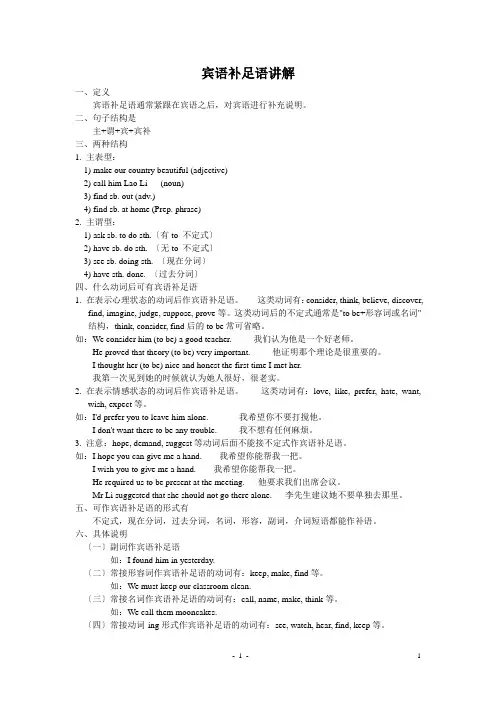
宾语补足语讲解一、定义宾语补足语通常紧跟在宾语之后,对宾语进行补充说明。
二、句子结构是主+谓+宾+宾补三、两种结构1. 主表型:1) make our country beautiful (adjective)2) call him Lao Li (noun)3) find sb. out (adv.)4) find sb. at home (Prep. phrase)2. 主谓型:1) ask sb. to do sth.〔有to 不定式〕2) have sb. do sth. 〔无to 不定式〕3) see sb. doing sth. 〔现在分词〕4) have sth. done. 〔过去分词〕四、什么动词后可有宾语补足语1. 在表示心理状态的动词后作宾语补足语。
这类动词有:consider, think, believe, discover,find, imagine, judge, suppose, prove等。
这类动词后的不定式通常是"to be+形容词或名词"结构,think, consider, find后的to be常可省略。
如:We consider him (to be) a good teacher.我们认为他是一个好老师。
He proved that theory (to be) very important.他证明那个理论是很重要的。
I thought her (to be) nice and honest the first time I met her.我第一次见到她的时候就认为她人很好,很老实。
2. 在表示情感状态的动词后作宾语补足语。
这类动词有:love, like, prefer, hate, want,wish, expect等。
如:I'd prefer you to leave him alone.我希望你不要打搅他。
I don't want there to be any trouble.我不想有任何麻烦。
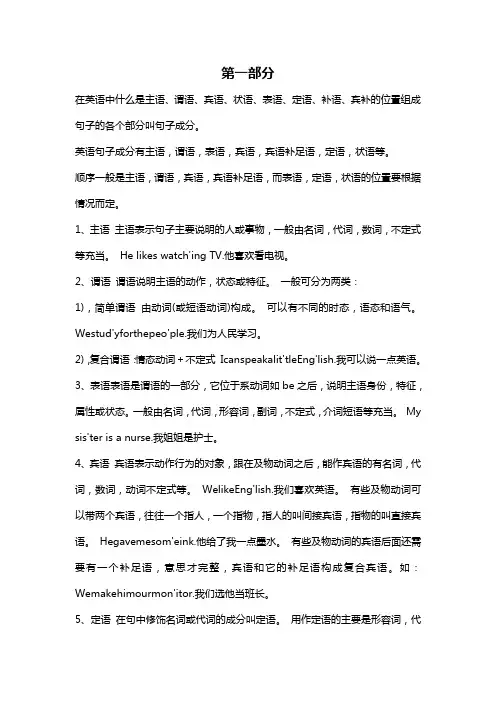
第一部分在英语中什么是主语、谓语、宾语、状语、表语、定语、补语、宾补的位置组成句子的各个部分叫句子成分。
英语句子成分有主语,谓语,表语,宾语,宾语补足语,定语,状语等。
顺序一般是主语,谓语,宾语,宾语补足语,而表语,定语,状语的位置要根据情况而定。
1、主语主语表示句子主要说明的人或事物,一般由名词,代词,数词,不定式等充当。
He likes watch'ing TV.他喜欢看电视。
2、谓语谓语说明主语的动作,状态或特征。
一般可分为两类:1),简单谓语由动词(或短语动词)构成。
可以有不同的时态,语态和语气。
Westud'yforthepeo'ple.我们为人民学习。
2),复合谓语:情态动词+不定式Icanspeakalit'tleEng'lish.我可以说一点英语。
3、表语表语是谓语的一部分,它位于系动词如be之后,说明主语身份,特征,属性或状态。
一般由名词,代词,形容词,副词,不定式,介词短语等充当。
My sis'ter is a nurse.我姐姐是护士。
4、宾语宾语表示动作行为的对象,跟在及物动词之后,能作宾语的有名词,代词,数词,动词不定式等。
WelikeEng'lish.我们喜欢英语。
有些及物动词可以带两个宾语,往往一个指人,一个指物,指人的叫间接宾语,指物的叫直接宾语。
Hegavemesom'eink.他给了我一点墨水。
有些及物动词的宾语后面还需要有一个补足语,意思才完整,宾语和它的补足语构成复合宾语。
如:Wemakehimourmon'itor.我们选他当班长。
5、定语在句中修饰名词或代词的成分叫定语。
用作定语的主要是形容词,代词,数词,名词,副词,动词不定式,介词短语等。
形容词,代词,数词,名词等作定语时,通常放在被修饰的词前面。
Heisanewstu'dent.他是个新生。
但副词,动词不定式,介词短语等作定语时,则放在被修饰的词之后。
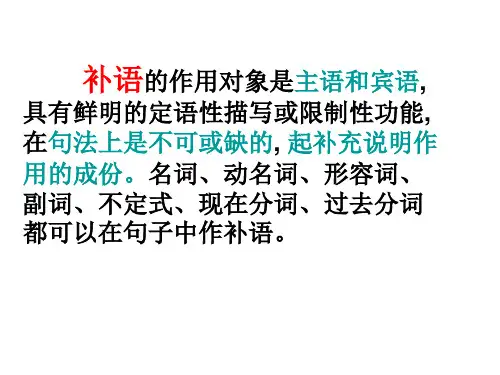
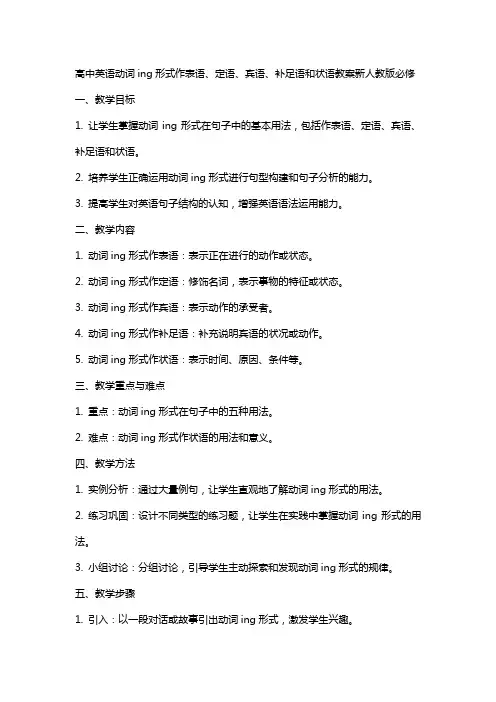
高中英语动词ing形式作表语、定语、宾语、补足语和状语教案新人教版必修一、教学目标1. 让学生掌握动词ing形式在句子中的基本用法,包括作表语、定语、宾语、补足语和状语。
2. 培养学生正确运用动词ing形式进行句型构建和句子分析的能力。
3. 提高学生对英语句子结构的认知,增强英语语法运用能力。
二、教学内容1. 动词ing形式作表语:表示正在进行的动作或状态。
2. 动词ing形式作定语:修饰名词,表示事物的特征或状态。
3. 动词ing形式作宾语:表示动作的承受者。
4. 动词ing形式作补足语:补充说明宾语的状况或动作。
5. 动词ing形式作状语:表示时间、原因、条件等。
三、教学重点与难点1. 重点:动词ing形式在句子中的五种用法。
2. 难点:动词ing形式作状语的用法和意义。
四、教学方法1. 实例分析:通过大量例句,让学生直观地了解动词ing形式的用法。
2. 练习巩固:设计不同类型的练习题,让学生在实践中掌握动词ing形式的用法。
3. 小组讨论:分组讨论,引导学生主动探索和发现动词ing形式的规律。
五、教学步骤1. 引入:以一段对话或故事引出动词ing形式,激发学生兴趣。
2. 讲解:详细讲解动词ing形式作表语、定语、宾语、补足语和状语的用法。
3. 举例:给出典型例句,分析并解释动词ing形式在不同用法中的含义。
4. 练习:让学生完成相关练习题,检验对动词ing形式用法的掌握程度。
6. 作业布置:设计课后作业,巩固所学内容。
7. 课后反思:教师对本节课的教学效果进行反思,为下一步教学做好准备。
六、教学拓展1. 引导学生运用动词ing形式进行句子创新,提高语言运用能力。
2. 对比分析动词ing形式和动词-ing形式在意义和用法上的差异。
3. 介绍动词ing形式在英语写作中的作用,提高学生写作水平。
七、课堂互动1. 提问:让学生回答关于动词ing形式的问题,加深对知识点的理解。
2. 讨论:组织学生就动词ing形式的用法展开讨论,分享学习心得。
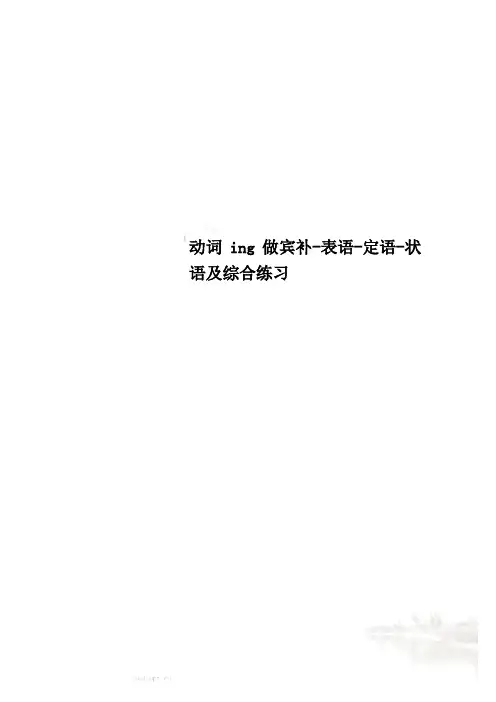
动词ing做宾补-表语-定语-状语及综合练习2高中英语语法动词ing形式做宾补表语定语状语用法详解及练习第一部分:动词的-ing形式作宾语补足语1.动词的-ing形式可以在see, hear, notice, watch, feel, smell, look at, listen to, observe, find 等表示感官和心理状态的动词后面作宾语补足语,和一个名词或代词一起构成复合宾语。
We heard the children shouting upstairs. 我们听见孩子们在楼上叫喊。
I noticed a man running out of the bank when I got off the car. 我下车的时候注意到一个男人从银行里跑出来。
I felt my heart beating violently. 我觉得我的心在猛烈地跳动。
2.动词的-ing形式和不定式作宾语补语的区别在see, hear, feel, watch, notice等感官动词后,既可用动词的-ing形式构成复合宾语,也可用不定式构成复合宾语,两者之间有一定的区别。
用动词的-ing形式时,表示动作正在进行;用不定式时,表示动作发生了,即动作的全过程结束了。
He saw a girl getting on the car. 他看见一个女孩在上汽车。
(She was getting on the car.)He saw a girl get on the car and drive off. 他看见一个女孩上车开走了。
(She got on the car and drove off.)Do you hear someone knocking at the door 你听见有人在敲门吗?(Someone is knocking at the door.)Do you hear someone knock at the door 你听见有人敲门了吗?(Someone knocked at the door just now.)提示:如果宾语补足语是一系列的动作,通常只能用不定式来表示,不用动词的-ing形式。
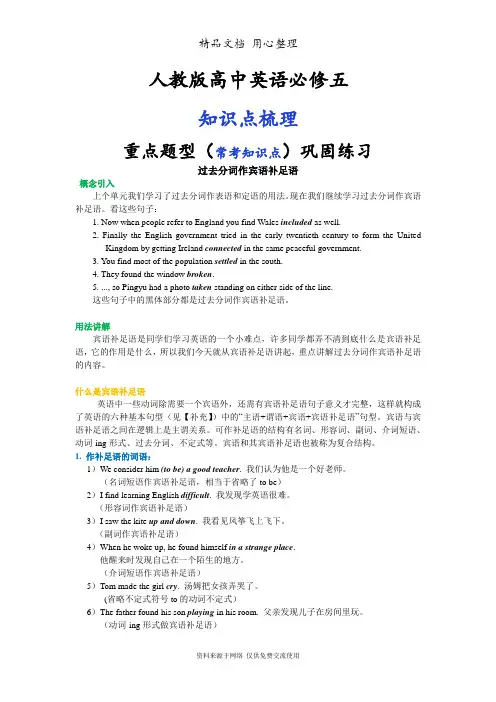
人教版高中英语必修五知识点梳理重点题型(常考知识点)巩固练习过去分词作宾语补足语概念引入上个单元我们学习了过去分词作表语和定语的用法。
现在我们继续学习过去分词作宾语补足语。
看这些句子:1. Now when people refer to England you find Wales included as well.2. Finally the English government tried in the early twentieth century to form the UnitedKingdom by getting Ireland connected in the same peaceful government.3. You find most of the population settled in the south.4. They found the window broken.5. ..., so Pingyu had a photo taken standing on either side of the line.这些句子中的黑体部分都是过去分词作宾语补足语。
用法讲解宾语补足语是同学们学习英语的一个小难点,许多同学都弄不清到底什么是宾语补足语,它的作用是什么,所以我们今天就从宾语补足语讲起,重点讲解过去分词作宾语补足语的内容。
什么是宾语补足语英语中一些动词除需要一个宾语外,还需有宾语补足语句子意义才完整,这样就构成了英语的六种基本句型(见【补充】)中的“主语+谓语+宾语+宾语补足语”句型。
宾语与宾语补足语之间在逻辑上是主谓关系。
可作补足语的结构有名词、形容词、副词、介词短语、动词-ing形式、过去分词、不定式等。
宾语和其宾语补足语也被称为复合结构。
1. 作补足语的词语:1)We consider him (to be) a good teacher. 我们认为他是一个好老师。
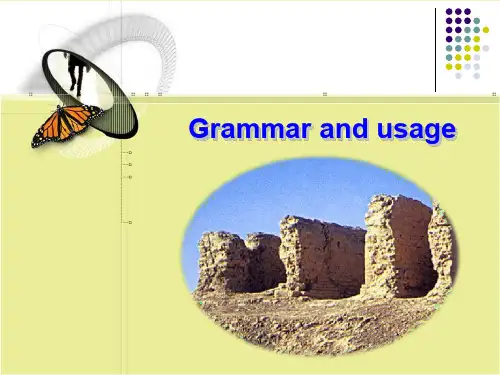
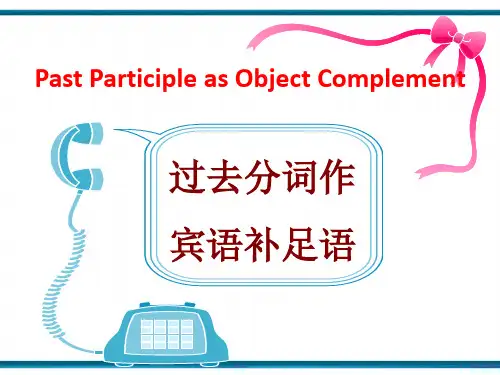
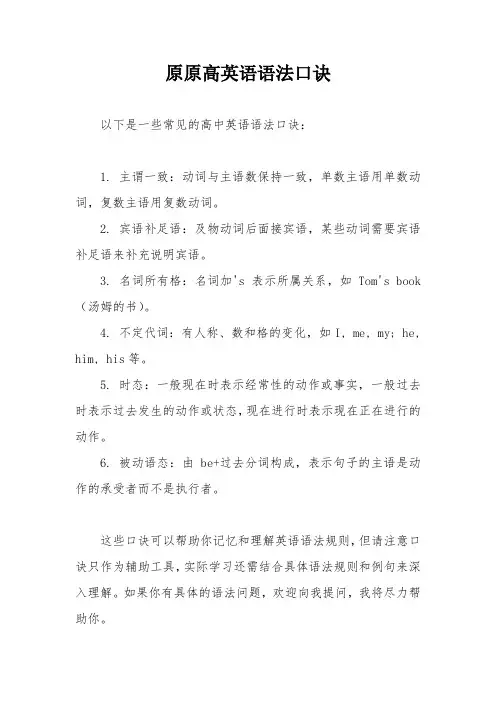
原原高英语语法口诀
以下是一些常见的高中英语语法口诀:
1. 主谓一致:动词与主语数保持一致,单数主语用单数动词,复数主语用复数动词。
2. 宾语补足语:及物动词后面接宾语,某些动词需要宾语补足语来补充说明宾语。
3. 名词所有格:名词加's表示所属关系,如Tom's book (汤姆的书)。
4. 不定代词:有人称、数和格的变化,如I, me, my; he, him, his等。
5. 时态:一般现在时表示经常性的动作或事实,一般过去时表示过去发生的动作或状态,现在进行时表示现在正在进行的动作。
6. 被动语态:由be+过去分词构成,表示句子的主语是动作的承受者而不是执行者。
这些口诀可以帮助你记忆和理解英语语法规则,但请注意口诀只作为辅助工具,实际学习还需结合具体语法规则和例句来深入理解。
如果你有具体的语法问题,欢迎向我提问,我将尽力帮助你。
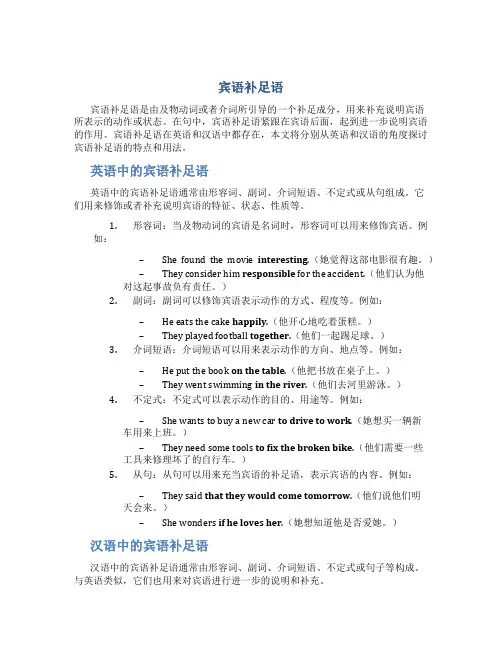
宾语补足语宾语补足语是由及物动词或者介词所引导的一个补足成分,用来补充说明宾语所表示的动作或状态。
在句中,宾语补足语紧跟在宾语后面,起到进一步说明宾语的作用。
宾语补足语在英语和汉语中都存在,本文将分别从英语和汉语的角度探讨宾语补足语的特点和用法。
英语中的宾语补足语英语中的宾语补足语通常由形容词、副词、介词短语、不定式或从句组成。
它们用来修饰或者补充说明宾语的特征、状态、性质等。
1.形容词:当及物动词的宾语是名词时,形容词可以用来修饰宾语。
例如:–She found the movie interesting.(她觉得这部电影很有趣。
)–They consider him responsible for the accident.(他们认为他对这起事故负有责任。
)2.副词:副词可以修饰宾语表示动作的方式、程度等。
例如:–He eats the cake happily.(他开心地吃着蛋糕。
)–They played football together.(他们一起踢足球。
)3.介词短语:介词短语可以用来表示动作的方向、地点等。
例如:–He put the book on the table.(他把书放在桌子上。
)–They went swimming in the river.(他们去河里游泳。
)4.不定式:不定式可以表示动作的目的、用途等。
例如:–She wants to buy a new car to drive to work.(她想买一辆新车用来上班。
)–They need some tools to fix the broken bike.(他们需要一些工具来修理坏了的自行车。
)5.从句:从句可以用来充当宾语的补足语,表示宾语的内容。
例如:–They said that they would come tomorrow.(他们说他们明天会来。
)–She wonders if he loves her.(她想知道他是否爱她。
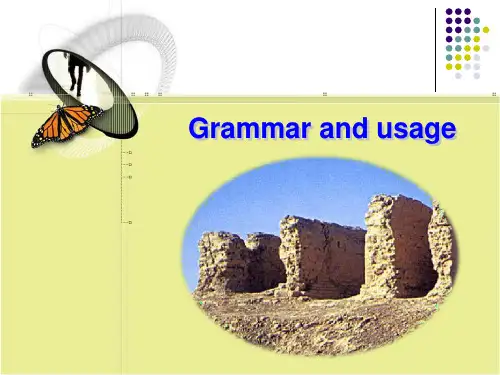
高中英语语法宾语补足语讲解举例:I going to paint it pink.我打算把它涂成粉红色(选自《新概念英语第一册》)句子中的“it”明显是宾语。
然而主语将要做的并不是it,而是“paint it pink”。
“pink”是句子中的宾语补足语。
它和宾语之间是逻辑上的主谓关系,也确实是说从逻辑上来讲,是pink出现了it的状态,让句子意思更加完整。
那个地点的宾语it与宾补pink的关系是主语与表语的关系(即主系表结构),如大伙儿所知,主系表结构是为了出现主语的特点特点、状态、身份等信息。
本质意思是it is pink,形式表现是it pink。
句子中的“pink”是形容词做宾语补足语。
能够充当宾补的大致还有:不定式,现在分词,过去分词,副词,介宾短语。
一样情形下,宾补通常紧跟在宾语之后。
比如:I find learning English difficult.(difficult是形容词做宾补)I saw the kite up and down.(up and down是副词做宾补)Tom made the girl cry.(cry是省略不定式符号to的动词不定式)常跟复合宾语的动词有:call(叫),named(叫做),make(做),t hink(摸索),find(找),leave(离开),keep(保持),nominate(任命),choose,elect(选举),define(定义),regard(认为),see(看),recognize(认出),treat,take,consider(考虑),look up,refer to(提到),accept(同意),acknowledge(承认),describe,depict(描述),represent(表现出),declare(宣称),denounce(指责),employ(雇佣),use(使用),show(展现),organize,express(表达)等。
宾语补足语举例:I going to paint it pink.我打算把它涂成粉红色(选自《新概念英语第一册》)句子中的“it显”然是宾语。
但是主语将要做的并不是it,而是“paint it pink。
“p”ink 是句子中的宾语补足语。
它和宾语之间是逻辑上的主谓关系,也就是说从逻辑上来讲,是pink 呈现了it 的状态,让句子意思更加完整。
这里的宾语it 与宾补pink 的关系是主语与表语的关系(即主系表结构),如大家所知,主系表结构是为了呈现主语的特点特征、状态、身份等信息。
本质意思是it is pink ,形式表现是it pink。
句子中的“pink是”形容词做宾语补足语。
能够充当宾补的大致还有:不定式,现在分词,过去分词,副词,介宾短语。
一般情况下,宾补通常紧跟在宾语之后。
比如:I find learning English difficult. (difficult 是形容词做宾补)I saw the kite up and down.(up and down是副词做宾补)Tom made the girl cry.(cry 是省略不定式符号to 的动词不定式)常跟复合宾语的动词有:call(叫),named(叫做),make(做),think (思考),find(找),leave(离开),keep(保持),nominate(任命),choose,elect(选举),define(定义),regard(认为),see(看),recognize(认出),treat,take,conside(r 考虑),look up,refer to(提到),accep(t 接受),acknowledge (承认),describe,depict(描述),represent(表现出),declare (宣称),denounce(指责),employ(雇佣),use(使用),show(展示),organize,express(表达)等。
高中英语必修二Unit 4过去分词作定语和宾语补足语精讲一、过去分词作定语1.意义:及物动词的过去分词作定语往往表示被动和完成;不及物动词的过去分词作定语不表示被动,只表示完成。
(1)表示被动和完成a polluted river一条被污染的河流the watered flowers浇过水的花(2)只表示完成,不表示被动fallen leaves落叶the risen sun升起的太阳2.位置:单个的过去分词作定语时,通常放在被修饰词的前面;过去分词短语作定语时,通常放在被修饰词的后面,其作用相当于一个定语从句。
The student dressed in white is my daughter.=The student who is dressed in white is my daughter.穿白色衣服的那个学生是我女儿。
注意:过去分词作定语和现在分词作定语的区别:(1)语态不同:现在分词表示主动;过去分词表示被动。
The question discussedwas very important.讨论过的那个问题很重要。
The house standing at thecorner of the street was built in 2016.矗立在街道角落的那所房子是2016年建的。
(2)时间关系上不同:现在分词表示动作正在进行;过去分词表示动作已经完成。
3.过去分词(done)、现在分词的被动语态(being done)与动词不定式的被动语态(to be done)意义形式语态时态done 被动完成being done 被动进行to be done 被动尚未发生去年建造的楼是我们的教学楼。
The buildingbeing built now is our classroombuilding.现在正在建造的楼是我们的教学楼。
The buildingto be built next month is ourclassroom building.下个月将要建造的楼是我们的教学楼。
宾语补足语讲解一、定义宾语补足语通常紧跟在宾语之后,对宾语进行补充说明。
二、句子结构是主+谓+宾+宾补三、两种结构1. 主表型:1) make our country beautiful (adjective)2) call him Lao Li (noun)3) find sb. out (adv.)4) find sb. at home (Prep. phrase)2. 主谓型:1) ask sb. to do sth.(有to 不定式)2) have sb. do sth. (无to 不定式)3) see sb. doing sth. (现在分词)4) have sth. done. (过去分词)四、什么动词后可有宾语补足语1. 在表示心理状态的动词后作宾语补足语。
这类动词有:consider, think, believe, discover,find, imagine, judge, suppose, prove等。
这类动词后的不定式通常是"to be+形容词或名词"结构,think, consider, find后的to be常可省略。
如:We consider him (to be) a good teacher.我们认为他是一个好老师。
He proved that theory (to be) very important.他证明那个理论是很重要的。
I thought her (to be) nice and honest the first time I met her.我第一次见到她的时候就认为她人很好,很诚实。
2. 在表示情感状态的动词后作宾语补足语。
这类动词有:love, like, prefer, hate, want,wish, expect等。
如:I'd prefer you to leave him alone.我希望你不要打扰他。
I don't want there to be any trouble.我不想有任何麻烦。
3. 注意:hope, demand, suggest等动词后面不能接不定式作宾语补足语。
如:I hope you can give me a hand. 我希望你能帮我一把。
I wish you to give me a hand. 我希望你能帮我一把。
He required us to be present at the meeting.他要求我们出席会议。
Mr Li suggested that she should not go there alone.李先生建议她不要独自去那里。
五、可作宾语补足语的形式有不定式,现在分词,过去分词,名词,形容,副词,介词短语都能作补语。
六、具体说明(一)副词作宾语补足语如:I found him in yesterday.(二)常接形容词作宾语补足语的动词有:keep, make, find等。
如:We must keep our classroom clean.(三)常接名词作宾语补足语的动词有:call, name, make, think等。
如:We call them mooncakes.(四)常接动词-ing形式作宾语补足语的动词有:see, watch, hear, find, keep等。
如:In the country, we can hear birds singing.(五)常接介词短语作宾语补足语的动词有:keep, find, leave等。
如:I left my pen on my desk at home.(六)不定式作宾语补足语1. 常接带to的动词不定式作宾语补足语的动词有:ask, tell, want, teach, wish, advise,allow, ask, beg, command, tell, invite, force, oblige, get, help, encourage, persuade,permit, remind, request, order, warn, cause等;如:She often asks me to help her.We don't allow such things to happen again.Most of the parents agree to forbid their children to smoke.She asked me to answer the phone in her absence.Please remind me to leave her this note.She requested him to go with her.2. 接不带to的动词不定式作宾语补足语的动词有:see, watch, hear, make, let等。
如:I often see him play football.3. 用不定式作宾语补足语的几种说明:①help后面作宾语补足语的动词不定式可以带to也可以不带to。
如:I often help my mother(to) do some housework.②一些动词跟不定式作宾语补足语时省去了to,这些动词有:一感二听三让四观看。
一感:feel;二听:hear, listen to;三让:let, have, make;四观看:observe,see, watch, look at。
③在使役动词后作宾语补足语,不定式不带to。
这类动词还有:make, let, have等。
转为被动语态时,其后通常都用带to的不定式(have没有被动语态)。
如:What would you have me do?你要我做什么?She made him give up smoking.她让他戒了烟。
Let him do whatever he wishes to do.他想干什么就让他干吧。
Though he had often made his little sister cry, today he was made to cry byhis little sister.虽然经常是他弄哭小妹妹,但今天他却被小妹妹弄哭了。
4. 掌握“使役动词have + 宾语+过去分词”的几种含义在“have +宾语+过去分词”结构中,过去分词作宾语补足语,have也可用get。
这一结构具有以下几种含义:①意为“主语请别人做某事”。
例如:如:He wants to have his eyes examined tomorrow.他明天想去检查眼睛。
(“检查”的动作由医生来进行)②意为“主语遭遇、遭受某一不愉快、不测的事情”。
例如:如:Be careful, or you'll have your hands hurt. 当心,否则会弄伤手的。
③意为“使完成某事”,事情既可以是别人做完,也可以由主语参与完成。
如:He had the walls painted this morning.他今早把墙漆了。
(主语自己可能参与)④动词不定式也可作一些短语动词的宾语补足语。
如:I'm waiting for James to arrive.我正等着詹姆斯的到来。
He's arranged for a car to pick them up at the station.他已安排了一辆汽车去车站接他们。
The UN has called on both sides to observe the cease fire.联合国号召交战双方遵守停火协定。
(七)分词作宾语补足语用现在分词作宾补,说明宾语是动作的发出者,形成逻辑上的主谓关系;用过去分词作宾补,表示宾语是动作的承受者,构成逻辑上的动宾关系。
1. 跟分词作宾补的动词有:catch, have get, keep, hear, find, feel, leave, make, want, start, notice,observe, watch, set等。
如:There was so much noise that the speaker couldn’t make himself heard.由于十分吵闹,讲话人没法让人听到他的声音。
When he awoke, he found himself being looked after by an old woman.他醒来的时候发现一位老大娘正在照顾他。
2. 几种用过去分词作宾语补足语的情况说明:①表示“意欲;命令”的动词如like, want, wish, order 等,可用过去分词作宾语补足语。
如:The father wants his daughter taught the piano. 这位父亲想让女儿学钢琴。
②感官动词see, hear, notice, observe, watch, feel, find 等后,可用过去分词作宾语补足语。
如:I saw an old man knocked down by a car just now. 刚才我看到一位老人被车撞倒了。
③使役动词have, get, make, leave, keep 等后,可用过去分词作宾语补足语。
如:Have you got your films developed? 你拿胶卷去冲洗了没有?④“with+宾语+过去分词”结构中,过去分词用作介词with 的宾语补足语。
这一结构通常在句中作时间、方式、条件、原因等状语。
如:The murderer was brought in, with his hands tied behind his back.凶手被带进来了,他的双手被绑在背后。
(表方式)With water heated, we can see the steam. 水一被加热,我们就会看到水蒸气。
(表条件)With the matter settled, we all went home. 事情得到解决,我们都回家了。
(表原因)【练习题】1. The manager discussed the plan that they would like to see the next year.(NMET2000)A. carry outB. carrying outC. carried outD. to carry out2. ----There’s a hole in your bag. ---- I know, I’m going to have it _____.A. mendB. mendingC. mendedD. to be mended3. Though he had often made his little sister ____, today he was made ____ by his little sister.A. cry; to cryB. crying; cryingC. cry; cryD. to cry; cry4. They would not allow him _____ across the enemy line.A. to risk goingB. risking to goC. for risk to goD. risk going5. I found the door _____ when I got home.A. openedB. closeC. unlockingD. open6. The boy wanted to ride his bicycle in the street, but his mother told him ___.A. not toB. not to doC. not doD. do not to7. I couldn’t do my homework with all that noise____.A. going onB. goes onC. went onD. to go on8. With a lot of difficult problems_____, the newly-elected president is having a hard time.A. settledB. settlingC. to settleD. being settled9. I advised _____ at once.A. him to startingB. him to startC. to startingD. to start10. When I put my hand on his chest, I could feel his heart still ____.A. beatB. to be beatingC. beatingD. was beating11. You had better get a doctor _____ your bad tooth.A. pull outB. to pull outC. pulled outD. pulling out12. He managed to make himself with his____ English.A. understand; breakingB. understand; brokenC. understood; breakingD. understood; broken13. The doctor asked him not to leave his wound ______.A. exposeB. exposedC. to exposeD. exposing14. They are going to have the service man ____ an electric fan in the office tomorrow.A. installB. to installC. to be installedD. installed15. After a few rounds of talks, both sides regarded the territory dispute ______.A. being settledB. to be settledC. had settledD. as settled16. You will see this product ____ wherever you go.A. to be advertisedB. advertisedC. advertiseD. advertising17. His remarks left me _____ about his real purpose.A. wonderedB. wonderC. to wonderD. wondering18. When I caught him ______ me I stopped buying things there and started dealing with anothershop.A. cheatingB. cheatC. to cheatD. to be cheating19. Though he had often made his little sister ____, today he was made ____ by his little sister.A. cry; to cryB. crying; cryingC. cry; cryD. to cry; cry20. Did you intend us ___ the new method?A. usingB. to useC. usingD. are using21. The teacher encouraged us ______ good compositions.A. WritingB. writtenC. to writeD. is writing22. The boy wanted to ride his bicycle in the street, but his mother told him ___________.A. not toB. not to doC. not do itD. do not to23. Mrs. Brown was much disappointed to see the washing machine she had had _______wentwrong again.A .it B. it repaired C .repaired D. to be repaired24. With a lot of difficult problems_____, the newly—elected president is having a hard time.A .settled B. settling C. to settle D. being settled25. With trees, flowers and grass_____ everywhere, my native town had taken on a new look.A. plantingB. plantedC. to plant D .to be planted26. She was glad to see her child well_____ care of.A. takeB. to be takenC. takenD. taking27. The result of the entrance exams was not made _____to the public until last Thursday.A. knowingB. knownC. to knowD. to be known28. I can make you _____what I say, but you can’t make yourself ____ in English.A. understand; understandB. understand, understoodC. to understand, understandD. understand; to be understood29. He found them ____ at a table_____.A. sat; to play chessB. sitting; to play chessC. seated; playing chessD. seat; play the chess30. John rushed out in a hurry, ___ the door_____.A. leaving; unlockedB. leaving; unlockingC. left; unlockedD. to leave; unlocking31. We are pleased to see the problem ___ so quickly.A. settledB. settlingC. be settledD. having been settled32. I could feel the wind ___ on my face from an open window.A .to blowB .blowing C. to be blowing D .blown33. ____ production up by 60%,the company has had another excellent year.A. AsB. ForC. WithD. Through34. ____ everything ____, she left the supermarket with satisfaction.A. As, buyingB. For, to buyC. With, bought D .Because, to buy35. Don’t leave the wa ter ____ while you brush your teeth. (天津2004)A. runB. runningC. being runD. to run36. He looked around and caught a man ___ his hand into the pocket of a passenger.A. putB. to be puttingC. to putD. putting37. Law s that punish parents for their little children’s actions against the laws get parents _______.(重庆2004)A. worriedB. to worryC. worryingD. worry38. The teacher asked us _____ so much noise. (北京2003)A. don’t makeB. not makeC. not makingD. not to make39. An army spokesman stressed that all the soldiers had been ordered ____ clear warnings beforefiring any shots. (上海2003)A. to issueB. being issuedC. to have issuedD. to be issued40.-Good morning. Can I help you? -I'd like to have this package __ ,Madame.A. be weighedB. to be weighedC. to weighD. weighed41. Father will not __us to use his recorders.A. haveB. let C .agree D. allow42. John was made __the truck for a week as punishment.A .to wash B. washing C. wash D. to be washing43. The missing boys were last seen __ near the river.A. playingB. to be playingC. playD. to play44. Paul doesn't have to be made __ .He always works hard.A. learnB. to learn C .learned D. learning45. Seeing the sun __ above the surface of the sea, we let out a shout of joy.A. to riseB. to raiseC. rising D .raising46. I was disappointed to find his suggestions __ .A been turned down B. turned down C. to be turned down D. to turn down47. The patient was warned ____oily food after the operation.A. to eat toB. eating not C .not to eat D not eating48. The speaker raised her voice but still couldn’t make herself _______.A. hearB. hearingC. to hearD. heard49. If you go to Xi’an, you’ll find the palaces there more magnificent than commonly _________.A. supposingB. to supposeC. supposedD. suppose50. It’s so cold today, we must keep the fir e ________.A. to burnB. burningC. burnD. burnt51. The mother was asked ________ let her children ________ TV every evening;A. not to; watchB. not to; to watchC. not; watchD. not; watching52. They didn’t observe her _______ in and go upstairs.A. comeB. cameC. to comeD. coming53. How about the two of us ____ a walk down the garden? (MET93 17)A. to takeB. takeC. takingD. to be taking54. I have had my bike , and I’m going to have somebody my radio tomorrow.A. repair; to repairB. repairing; to be repairedC. repaired; repairD. to repair; repairing55. _________ the room, the nurse found the tape recorder _________.A. Entering; stealingB. Entering; goneC. To have entered; being stolenD. Having entered; to be stolen56. Could you show me the mobile phone you’d like ______?A. to have repairedB. repairing itC. having it repairedD. to repair it57. I have often heard the ABC Song , but I have never heard Alice it.A. to be sung; to singB. being sung; sangC. sung; singD. sang; singing58. I can hardly imagine Peter __________ across the Atlantic Ocean in five days.A. sailB. to sailC. sailingD. to have sailed59. --- Have you had anyone ______ your newly-bought flat?--- Not yet. I am going to get John _______ a design for it first.A. to decorate; makeB. to decorate; to makeC. decorate; makeD. decorate; to make60. ---“Did you have any difficulty in today’s homework?”---“No, in fact I found __________.”A. it very easy to doB. it very easy doneC. very easy for doingD. very easy to do it Keys:1-5 CCAAD 6-10 AACBC 11-15 BDBAD 16-20 CDAAB 21-25 CACAB26-30 CBBCA 31-35 ABCCB 36-40 DADAD 41-45 DAABC 46-50 BCDCB51-55 AACCB 56-60 ACCDA。